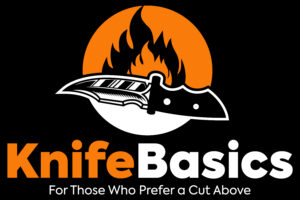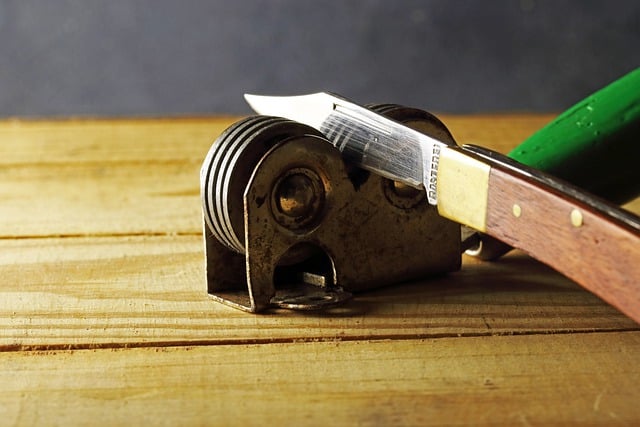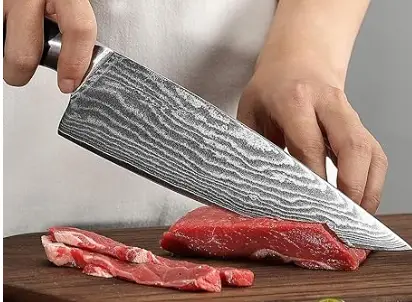What is 13C26 Steel?
Other manufacturers have also adopted Sandvik’s 13C26 Steel under different proprietary naming. The most common is Henckel’s in their Miyabi Kitchen Knives under the proprietary name FC61 Stainless Steel.
Sandvik 13C26 steel equivalent is Bohler AEB-L stainless with an additional 0.1% of alloying compounds. 13C26 steel is also greatly similar to 12C27 Steel but with improved Rockwell Hardness and reduced corrosion resistance.
Sandvik 13C26 Steel Composition
- Carbon C 0.68%: Increases edge retention, hardness, and tensile strength. It also improves steel resistance to wear, abrasion, and corrosion.
- Chromium Cr 13.00%: Formation of Chromium carbides. Increases the blade’s hardness, tensile strength, and corrosion resistance.
- Manganese Mn 0.70%: improves the strength and hardness of steel. When the steel is heat-treated, hardenability is improved with increased manganese.
- Silicon Si 0.4%: Increases strength and heat resistance.
- Sulfur S 0.01%: Improves machinability it is regarded as an impurity and may affect the performance of the steel.
- Phosphorous P 0.02%: Increases the strength and improves the machinability of steel but is regarded as an impurity.
Properties of 13C26 steel
13C26 Steel Hardness
13C26 steel has a Rockwell hardness of 61-62HRC, the hardness level achieved varies with the heat treatment method and tampering time of the manufacturer. Because of the high hardness, 13C26 knives can handle cutting tasks and maintain their edges for long. The high hardness also leads to benefits like great wear resistance..
13C26 Steel Edge retention
With a high hardness of 61HRC and fine-grained microstructure, 13C26 stainless steel offers good edge retention. It does not provide the best edge retention on the market, but you will not have to keep sharpening the blades after a few cuts.
13C26 steel has edge retention similar to that of Nitro V steel, AUS 8 steel, and 14C28 steel. Its edge retention is lower than that of popular Japanese VG10 stainless steel and AISI 440C knife steel.
13C26 Steel Wear resistance
Knife blades wear and tear with frequent use and sharpening. No matter how hard steel is, it bows down to abrasion at some point. Therefore, it is crucial to purchase a knife that can withstand abrasion, and Sandvik 13C26 falls in that category.
13C26 blades will serve you for a long time, and they will not deform or lose shape. To improve their durability, it is advisable to sharpen them with whetstones instead of automatic sharpeners.
13C26 Steel Toughness
The toughness of steel is inversely proportional to its hardness. Therefore, steel can either offer you hardness or toughness but not both. Although 13C26 steel has a high hardness of 61HRC, it still offers very high toughness.
The high toughness of Sandvik 13C26 is attributed to its pure chemical composition. It contains very few impurities that lead to the formation of a fine-grained structure that positively influences its hardness and toughness.
13C26 knife steel toughness is better than most blade steels, its toughness level is equivalent to CPM 3V, 14C28N steel, and higher than CPM 4V. With such a high toughness level, 13C26 knives can be used for tough applications without chipping, breaking, or cracking.
13C26 Steel Corrosion resistance
Sandvik 13C26 steel is stainless steel as it contains over 13% chromium elements, and therefore it is resistant to corrosion and staining. 13C26 knives can be used in corrosive environments but are not well suited for highly corrosive environments. 13C26 steel is often recommended to be coated for enhanced corrosion resistance, especially in demanding cutting applications.
Although 13C26 is rust-resistant, it requires proper care and maintenance. All types of steel can rust when exposed to corrosion, which is valid with Sandvik 13C26. If you leave the blades in water for long hours, they will start to stain and rust after some time.
To keep your Sandvik 13C26 knives free from rust, wash and dry them immediately after use. If you plan to store them for a long time, remove them from the sheath and apply a coat of oil on the blades to keep rust at bay.
Ease of Sharpening 13C26 Steel
Sharpening 13C26 knives will be harder for you if you are a beginner in knife sharpening, but it will be easier if you use whetstones. Depending on the desired sharpness level, use different grades of whetstone as you progress to the finer grits.
13C26 steel comparison
13C26 vs AEB-L
13C26 is very similar to AEB-L steel. They have the same chemical composition with a slight difference in the percentages. As stated earlier AEB-L steel can be considered 13C26 steel equivalent as there is no difference in performance.
13C26 vs VG10
13C26 knife steel offers twice the toughness of VG10 because it is a pure alloy with a very fine microstructure. On the contrary, VG10 steel beats 13C26 in corrosion resistance and edge retention. The edge retention of VG10 stainless steel is outstanding because it contains Vanadium, which forms hard vanadium carbides.
13C26 vs 12C27
Both 13C26 steel and 12C27 steel are produced by Sandvik, they are quite similar in their properties but 13C26 has higher Rockwell hardness which translates to higher wear resistance and slightly better edge retention.
Sandvik 12C27 steel has a slightly higher chromium content in its alloy composition compared to Sandvik 13C26 knife steel. The increased chromium content enables it to provide better corrosion resistance.
13C26 vs 14C28N
Both 13C26 and 14C28N steel are manufactured by Sandvik and belong to their knife steel grade, offering almost similar properties but with higher corrosion resistance in 14C28N stainless steel due to its higher chromium percentage. In terms of toughness, edge retention, and wear resistance, there is no significant difference between 13C26 steel and 14C28N steel.
13C26 vs S30V
Sandvik 13C26 steel is better than S30V steel in toughness, it offers about twice the toughness of S30V steel. S30V steel on the other hand is better than 13C26 knife steel in edge retention and corrosion resistance. In general S30V steel is a more balanced knife steel and better than 13C26 stainless steel in EDC as it offers optimal performance in terms of edge retention, corrosion resistance, and wear resistance. Generally, S30V steel is considered superior to 13C26 in these aspects.
- 【Exclusive Built-in Sharpener】Kitchen knife set with sharpener is amazing. The self-sharpening block keeps the knives razor sharp effectively. It saves you from having to honing blades on a sharpening steel.
- 【Premium Knife Set】Made of forged, high-carbon one-piece German stainless steel, this cutlery knife block set is tarnish-resistant and rust-resistant. The knife set is well-made with a nice appearance. They are sharp, durable, and have good weight and balance, providing effortless cutting. Perfect for both professional chefs and beginner.
- 【Easy to Clean Up】: The kitchen knife set with block is easy and fast to clean. Hand-wash for best results. The blades are stainless and rust-free after going through washing.
- 【Easy to Store】: All knives are stored safely in the knife block with built-in sharpener for space efficient storage. The block is easy to clean and maintain. It is durable and doesn't take up too much space on the counter. Made of natural rubberwood,this wooden kitchen knife block is strong and sturdy to hold heavy knife sets and is finished with a beautiful veneer that’s naturally resistant to grime and easy to wipe clean
- 【Best Sharp Knife Set】Optimized weight and good balance make this kitchen knife set fit nicely in the palm of hand. Exclusive taper grind edge technology provides optimum sharpness for precise cutting and is easy to re-sharpen. The knives are sturdy and can handle heavy chopping. The knives set stays sharp even after extended use.
- Multipurpose Knife Set: This kitchen knives set includes 8" Chef Knife, 8" Slicing Knife, 7" Santoku Knife, 8" Serrated Bread Knife, 5" Utility Knife, 3.5" Paring Knife, Kitchen Shears and 6 pcs Blade Guards
- Anti-rust coating: The healthy anti-rust coating protects the knife from oxidation and dishwasher safe, while the non-stick coating ensures the blades stay clean all day long
- Easy to carry: Each knife comes with a blade guard for safe, compact storage in your kitchen cupboard. These knives are also easy to carry when camping or storing in your RV
- Perfect Holiday Gift: Ideal for kitchen enthusiasts or new cooks, this knife set meets all cooking needs. It makes an excellent holiday gift for family, friends, lover and colleague
- Lifetime Warranty: Every knife set is backed by rigorous quality inspection, we provide a lifetime warranty for every customer, ensuring superior customer service and peace of mind with every purchase
- ULTRA-SHARP BLADES: Superior professional-level sharpness that ensures precision cutting.
- THE LAST KNIFE YOU’LL EVER NEED TO BUY: German Engineered Knife Informed by over 100 Years of Mastery. HENCKELS knives are built to last.
- EFFORTLESS CUTTING: Enjoy easy cutting with minimal effort with this lightweight, easy-to-use knife.
- SET INCLUDES: 3-inch paring knife, 5-inch serrated utility knife, 7-inch santoku knife hollow edge, 8-inch chef's knife, 8-inch bread knife, 4.5-inch steak knife set of 6, professional honing steel, kitchen shears, and hardwood knife block
- QUICK CLEAN UP: No-fuss cleanup, in the dishwasher or by hand. Stain and rust-free blades.
Is 13C26 good knife steel?
Sandvik 13C26 steel is good knife steel, It offers moderate wear resistance, excellent corrosion resistance, and excellent toughness. Its major downside is its edge retention is lower compared to other knife steels in its price bracket. It’s hard to find knives with 13C26 steel as most knife makers prefer 14C28N due to its improved corrosion resistance. However, 13C26 steel is used in entry-level Kershaw knives, highlighting its balance of edge retention and corrosion resistance.






